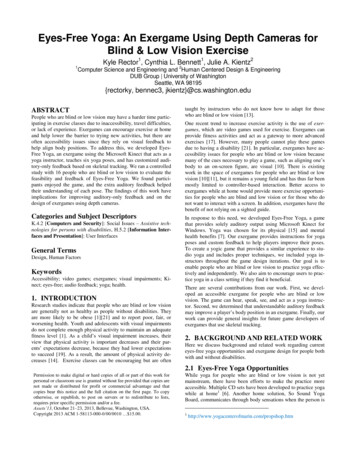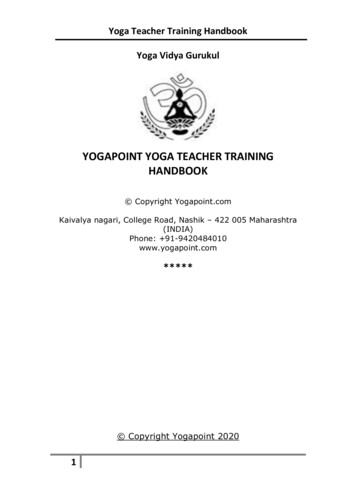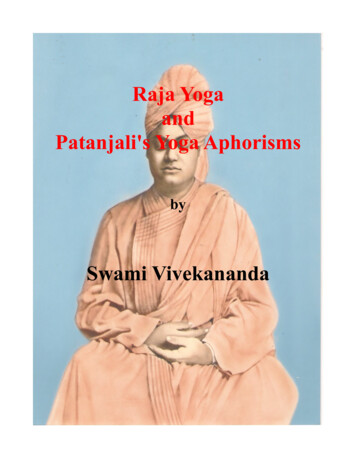
Transcription
Eyes-Free Yoga: An Exergame Using Depth Cameras forBlind & Low Vision Exercise1Kyle Rector1, Cynthia L. Bennett1, Julie A. Kientz22Computer Science and Engineering and Human Centered Design & EngineeringDUB Group University of WashingtonSeattle, WA 98195{rectorky, bennec3, jkientz}@cs.washington.eduABSTRACTPeople who are blind or low vision may have a harder time participating in exercise classes due to inaccessibility, travel difficulties,or lack of experience. Exergames can encourage exercise at homeand help lower the barrier to trying new activities, but there areoften accessibility issues since they rely on visual feedback tohelp align body positions. To address this, we developed EyesFree Yoga, an exergame using the Microsoft Kinect that acts as ayoga instructor, teaches six yoga poses, and has customized auditory-only feedback based on skeletal tracking. We ran a controlledstudy with 16 people who are blind or low vision to evaluate thefeasibility and feedback of Eyes-Free Yoga. We found participants enjoyed the game, and the extra auditory feedback helpedtheir understanding of each pose. The findings of this work haveimplications for improving auditory-only feedback and on thedesign of exergames using depth cameras.Categories and Subject DescriptorsK.4.2 [Computers and Security]: Social Issues – Assistive technologies for persons with disabilities, H.5.2 [Information Interfaces and Presentation]: User InterfacesGeneral TermsDesign, Human FactorsKeywordsAccessibility; video games; exergames; visual impairments; Kinect; eyes-free; audio feedback; yoga; health.1. INTRODUCTIONResearch studies indicate that people who are blind or low visionare generally not as healthy as people without disabilities. Theyare more likely to be obese [1][21] and to report poor, fair, orworsening health. Youth and adolescents with visual impairmentsdo not complete enough physical activity to maintain an adequatefitness level [1]. As a child’s visual impairment increases, theirview that physical activity is important decreases and their parents’ expectations decrease, because they had lower expectationsto succeed [19]. As a result, the amount of physical activity decreases [14]. Exercise classes can be encouraging but are oftentaught by instructors who do not know how to adapt for thosewho are blind or low vision [13].One recent trend to increase exercise activity is the use of exergames, which are video games used for exercise. Exergames canprovide fitness activities and act as a gateway to more advancedexercises [17]. However, many people cannot play these gamesdue to having a disability [21]. In particular, exergames have accessibility issues for people who are blind or low vision becausemany of the cues necessary to play a game, such as aligning one’sbody to an on-screen figure, are visual [10]. There is existingwork in the space of exergames for people who are blind or lowvision [10][11], but it remains a young field and has thus far beenmostly limited to controller-based interaction. Better access toexergames while at home would provide more exercise opportunities for people who are blind and low vision or for those who donot want to interact with a screen. In addition, exergames have thebenefit of not relying on a sighted guide.In response to this need, we developed Eyes-Free Yoga, a gamethat provides solely auditory output using Microsoft Kinect forWindows. Yoga was chosen for its physical [15] and mentalhealth benefits [7]. Our exergame provides instructions for yogaposes and custom feedback to help players improve their poses.To create a yogic game that provides a similar experience to studio yoga and includes proper techniques, we included yoga instructors throughout the game design iterations. Our goal is toenable people who are blind or low vision to practice yoga effectively and independently. We also aim to encourage users to practice yoga in a class setting if they find it beneficial.There are several contributions from our work. First, we developed an accessible exergame for people who are blind or lowvision. The game can hear, speak, see, and act as a yoga instructor. Second, we determined that understandable auditory feedbackmay improve a player’s body position in an exergame. Finally, ourwork can provide general insights for future game developers ofexergames that use skeletal tracking.2. BACKGROUND AND RELATED WORKHere we discuss background and related work regarding currenteyes-free yoga opportunities and exergame design for people bothwith and without disabilities.2.1 Eyes-Free Yoga OpportunitiesPermission to make digital or hard copies of all or part of this work forpersonal or classroom use is granted without fee provided that copies arenot made or distributed for profit or commercial advantage and thatcopies bear this notice and the full citation on the first page. To copyotherwise, or republish, to post on servers or to redistribute to lists,requires prior specific permission and/or a fee.Assets’13, October 21–23, 2013, Bellevue, Washington, USA.Copyright 2013 ACM 1-58113-000-0/00/0010 15.00.While yoga for people who are blind or low vision is not yetmainstream, there have been efforts to make the practice moreaccessible. Multiple CD sets have been developed to practice yogawhile at home1 [6]. Another home solution, So Sound YogaBoard, communicates through body sensations when the person is1http://www.yogacenterofmarin.com/propshop.htm
Mountain PoseWarrior IWarrior IIReverse WarriorTree PoseChair PoseFigure 1. The six poses used for evaluation, listed in the order in which they were performed.out of alignment and indicates which parts of the body are understress, but is expensive2. A less expensive solution, Visually Impaired Yoga Mat3, provides tactile cues for foot and hand placement. Some yoga instructors have spent a long period of timeworking with the visually impaired to gain a better understanding,such as being aware of the words used to instruct the class [9].One yoga instructor had sighted people use blindfolds to gainempathy [8]. Another group of instructors held poses and let thestudents feel them to gain a better understanding. Overall, most ofthe opportunities for people who are blind or low vision to engagein yoga have needed contact with a yoga instructor with theknowledge and experience to accommodate.2.2 ExergamesExergame design addresses two important goals: attractivenessand effectiveness [18]. The game should be enjoyable and have asense of “GameFlow” while still achieving the desired exercise.There are important factors addressed in GameFlow that we haveincluded in the design of Eyes-Free Yoga as well as evaluated forin our study using interviews: ability, concentration, challenge,skills, control, goals, and external factors [20]. Exergame effectiveness can be measured in energy expended or accuracy of theexercise. Because yoga is an anaerobic exercise and calorie expenditure is not a goal, we decided to involve yoga instructors inrating the quality of the yoga poses rather than energy expended.We followed the same considerations that are important for therapeutic exergaming [2] by including feedback to assist in playercompetence and enjoyment, but avoided visual feedback. Thegame is accessible along with the added benefit of not overwhelming a player while practicing yoga.Yoga exergames have been developed on the Wii Fit and the Kinect. In general, they are not accessible for eyes-free interactions.For example, the Wii Fit requires the television be at eye level fora player to view their progress. A recent Kinect-based exergame,Your Shape Fitness Evolved4, has yoga workouts that providevisual feedback to enable a player to correct their alignment.However, players are required to compare their body to an instructor avatar on the screen. Players need to keep their play spacegreen or “in sync” with the instructor. The required tasks for theirbody are displayed in text in the upper right corner of the screenand turn green when done correctly. The only audio cue is a bellsound informing that an adjustment was completed, but the particular adjustment suggestion is visual. There are verbal cues reliant on sight (i.e., "watch her feet") while others are accessible(i.e., "keep the lunge low"). Chopra’s Leela5 is a yoga exergamethat primarily uses visual feedback to enhance the experience.Eyes-Free Yoga uses positive aspects of each game, such as sug-gesting body adjustments and verbal and audio feedback to confirm that the player has finished a movement.Two strong efforts from the research community are the creationof accessible alternatives to Wii Sports games, VI-Bowling [11]and VI-Tennis [10]. Morelli et al. completed a careful analysis ofprimary (or necessary) visual cues used in Wii Sports Bowlingand Tennis, and converted them to audio feedback from thespeakers or tactile feedback from the Wii Remote. VI-Tennis wasevaluated with children. The researchers measured the differencein energy expenditure, scores, and enjoyment from the originalWii Sports game. They found that people scored better and enjoyed the game more with the accessible version and producedhealth benefits due to physical activity. VI-Bowling, evaluatedwith adults, was found to be enjoyable and a sufficient challenge.Morelli et al. developed a solution using sensory substitution tomake Kinect games accessible to for eyes-free interactions [12].Instead of adapting a current exergame, we developed our own byinvolving yoga instructors. We chose yoga because the slowerpace would not compromise verbal and auditory feedback.3. EYES-FREE YOGA DESIGNWe discuss in detail the six design principles used to inform ourdesign. These were identified from the goal of Eyes-Free Yoga:allow people who are visually impaired and new to yoga to learnthe practice and encourage in-person class attendance. We followwith a technical description of how we developed our exergame.3.1 Design PrinciplesEyes-Free Yoga uses the Kinect platform to guide players throughsix different yoga poses, recognize whether the player is in thecorrect position, and provide feedback on how to correct theirposition if they are not. We determined and followed six principles in designing Eyes-Free Yoga: accessible, yogic, encouragesconfidence, targeted to novices, accessibility features do not compromise learning, and encourages a challenging workout.3.1.1 Accessible for Eyes-Free InteractionEyes-Free Yoga was designed to be accessible for people who areblind and low vision. Consequently, this principle applies to anyone who could benefit from performing yoga without having tolook at a screen, which could be a form of situational impairment[16]. To reduce the risk of improperly described inadvertent visual cues, we completely removed the screen component. We consulted yoga materials specifically created for people with visualimpairments to capitalize on descriptive techniques and understandable words and phrases [6]. The exergame aspired to haveclear audio instructions and ease of interacting with a player. Participants used their voice to give commands and thus did not haveto acquaint themselves with a controller or novel equipment.23.1.2 Game Provides a Yogic Experience3Our goal with Eyes-Free Yoga was to create an experience comparable to attending a yoga class or performing yoga along withan audio/visual guide. To determine the six appropriate yoga positions and respective verbal feedback, we collaborated with eela.com/
yoga instructors and one yoga instructor in training, one of whichhad experience working with people who are blind or low vision.As an additional constraint, our poses needed to be compatiblewith Kinect’s Skeletal Tracking, which requires users to be in astanding position. Based on the yoga instructors’ feedback, wedetermined a set of six standing yoga poses for our study (Figure1). To gain a deeper understanding of the poses, the lead researcher took five courses on the fundamentals of yoga from oneof the yoga instructors. In addition, the training yoga instructorgave us a teacher-training manual authored by her school(hotyogaforlife.com). After developing the script and demonstrating our exergame, one instructor gave us specific feedback aboutthe most common mistakes made by people for each pose. Theyhelped edit the script and commands used to correct each mistake.We incorporated relaxing, meditative music in the background toenhance the experience. Another collaborating yoga instructorprovided the voice for the scripts to add more reality to the gameplay, rather than using computer-generated speech. Interactingwith the game using only their voice allowed participants to maintain the yogic experience by performing pose after pose withoutinterruption to manipulate a controller. We did not require anybody-worn sensors to increase comfort and used two standardyoga mats to replicate a yoga class. They were arranged in a plusshape to give participants bearings of the game space.3.1.3 Game Instills ConfidenceWe wanted to encourage confidence, future game play, and possible attendance at future yoga classes. We gave positive verbalcues for adjustments and by playing a wooden xylophone tonewhen the player achieved the correct adjustment. Participantswere told “Good job!” by the yoga instructor when they wereholding the pose correctly. This method affirmed to participantsthey were performing the pose correctly. Ideally, if they fixed theadjustments while at home and performed the corrected pose at anin-person class, the yoga instructor would have a positive review.3.1.4 Caters to a Novice Target AudienceThe target audience of our exergame was people who are new toyoga. We chose poses that serve as basis for learning more complex poses, and the poses gradually became more difficult as participants progressed through the game. We offered a modificationfor Tree Pose, a balance posture, for those whose balance waspoor. The participants had the option to perform the poses between 1 and 3 times depending on if they were tired. Our exergame asked the participants if they were experiencing back orknee pain. If a participant answered “yes,” the exergame wouldgive accommodating modifications so the participant could complete a modified pose. Along with utilizing nonvisual descriptions, we chose phrases that were not specific to yoga so peoplewho had never attended a yoga class could follow the directions.3.1.6 Encourages a Challenging WorkoutWe determined rules for each pose using skeletal tracking andcustom verbal corrections so the participants were only told“Good job!” when they performed the pose correctly. We did notoffer shortcuts, except to avoid injury, so participants were required to learn and achieve the pose to receive positive feedback.This would also provide the challenge element of GameFlow [20].3.2 Technical DevelopmentWe built our game using the Microsoft Kinect for Windows Software Development Kit (SDK) version 1.6 and C#, which includesspeech recognition. We used information from yoga instructors toprogram a set of rules for each pose. The rules utilized KinectSkeletal Tracking, which contains 20 body joints, to provide custom verbal corrections. The 20 joints recognized by the KinectSDK provide information about their X, Y, and Z position. Because we were able to calculate the distance between any twoskeletal points, we could calculate the different body angles usingthe Law of Cosines. For example, the game can calculate that the“armpit” angle is currently 45 and the proper angle should be atleast 80 (see Figure 2). The game responds with the appropriateverbal correction. To reduce errors with occlusion and rotation ofthe body [3], we determined how the participant should face theKinect based on the pose. We also used built-in “Joint Filtering”provided by the Kinect. As a result, we did not encounter anyissues with occlusion during the development or the studies.The rules were determined after reading yoga resources and asking yoga instructors for common errors. The lead researcher interviewed one yoga instructor at a yoga studio about important andunimportant aspects of each pose. The researcher would act outthe poses and possible errors to gain clarification. Each pose hadan average of 10.5 rules and a mode of 11 rules. The least constrained pose, Tree, had 7 rules due to the main focus on balance.People performing this posture could use their arms however theywanted. The most constrained pose, Reverse Warrior, had 12rules, because each limb was contributing something unique.Each violated rule provides the appropriate verbal correction tofix the issue. The rules have from 1 to 4 choices of verbal cor-3.1.5 Accessibility Does Not Hinder LearningWe wanted to design a game that offered comprehensive instructions and verbal corrections without interfering with the flow ofgame play. Participants could ease into the pose while hearingcomprehensive instructions. While holding a pose, the exergameoffered verbal adjustments and auditory confirmation to assist inpose improvement. Participants could master poses they mightencounter in yoga classes; we did not adapt any of the poses. Thismethod differs from class situations in which a pose description isgiven and the instructor has to then assist the person who is blindor low vision in achieving the pose while everyone else is alreadyholding their pose and possibly moving on.Figure 2. In Warrior II, her arms are at 45 and need to beraised to 80 . The Kinect responds with a verbal correction.
“Lean forward”“Rotate your shouldersright.”“Bend your right leg further”Figure 3. Priority of adjustments shown on the human body.The highest priority is the core, which is red (hot), and lowestpriority are the feet, which are purple (cold). The headorientation is not measured.rections to make based on the Kinect Skeletal Tracking data. Thesuggested verbal correction was prioritized by location of theissue. We designed the verbal feedback to first adjust the center ofthe body followed by the legs and arms to lessen the amount ofverbal corrections. The priority of corrections given is shown inFigure 3. The appendix provides detailed pseudocode examples ofthe rules and verbal corrections given for Warrior II. It is worthnoting that if an instruction had to be repeated four times in a row,the game would move forward to avoid frustrating a player.3.2.1 DiscussionKinect Skeletal Tracking does not adapt to bent knees, which iswhy the newest SDK removes the legs from Skeletal Tracking forseated users. The measured angles for the knees were higher thanexpected; a knee bent at a 90 angle would return a value closer to145 . The lead researcher stood in front of the Kinect and thenbent down to reach their toes. According to the Kinect, the lowerlegs shrunk by 3” and the upper legs shrunk by 7”. Recent Computer Vision research shows the potential to expand to more advanced poses and improve the issue encountered with bent knees[4], which we will use for a new version of Eyes-Free Yoga.4. EVALUATIONTo assess the ability of Eyes-Free Yoga to help novices learn newyoga poses and provide an enjoyable exercise experience, weconducted an evaluation with 16 participants who were blind orlow vision. Our study design used mixed methods and a quasiexperimental component where every participant practiced yogausing a baseline and experimental prototype version of the game: The baseline prototype provides step-by-step instructions toperform a pose with no feedback about how the participant isdoing. The experimental prototype is the same as the baseline prototype but provides custom verbal and auditory feedback to correct a player’s position.The study was counter-balanced in that participants were randomly placed into Group A (baseline first, experimental second) orGroup B (experimental first, baseline second). The game present-ed poses in the order shown in Figure 1 for both groups with 3poses per condition.4.1 Study Methodology and Data AnalysisWe interviewed participants to assess their experience practicingyoga and current exercise habits. Following the interview, theparticipants listened to a tutorial presented by the game to gainbearings of the game space. The yoga mats were arranged in aplus-formation, so the participants learned about “front, back,right, left, and base” location. These locations were referenced inthe instructions so the participants knew where to move. For example, Warrior Two began with spreading legs apart while facingthe Kinect: Stand in base. Stretch your arms out to the sides, andstep your feet apart until your heels are under your wrists. Relaxyour arms. They also listened to a tutorial about custom feedback:Group A listened after three poses and Group B listened at thebeginning. It stated they would hear more instructions followedby a tone when they completed the instruction correctly. The participants performed the six yoga poses up to three times each for15 seconds, or in the case of the experimental prototype, untilthey completed the verbal corrections.Upon game completion, we conducted a follow-up interview withparticipants to assess their perceived quality of the experience. Weasked participants about their thoughts of the game and askedthem to provide open responses about the usefulness of the customized feedback. The interviews were audio recorded and thegame session was video recorded, which we then transcribed andanalyzed. We extracted still photos from video recordings of theparticipants performing each pose while removing any identifyinginformation. We worked with four yoga instructors from thecommunity to rate the quality of each pose on a Likert Scale (1 –very bad to 5 – very good). The instructors were unaware ofwhich photos depicted a participant performing a pose with custom feedback versus one performing without custom feedback.4.2 ParticipantsWe recruited 16 participants who were blind or low vision toparticipate in our study. There were 8 females and 8 males, and 12were completely blind while 4 were low vision. Their average agewas 23.8 years with a range between 13 and 60 years. We recruited participants through email lists and by partnering with theWashington State School for the Blind. The study was conductedat the school and at the University of Washington. The participants spent between 45 and 90 minutes completing the study andwere compensated with 20 cash. Participants were evenly divided with regard to previous yoga experience: 5 had never practicedyoga, 6 had little experience, and 6 had taken yoga classes. Tenparticipants had attended exercise classes besides yoga, many ofthem through their school. Reasons participants gave for not attending classes included lack of time (1), not being able to followan exercise class (2), difficulty finding the right class (1), and itnot being a priority (2). Six participants mentioned the importanceof extra audio instructions in a proposed class setting, which maynot be fulfilled in current yoga classes.5. RESULTSBelow we describe the results of Eyes-Free Yoga’s custom feedback on the users’ performance and how the yoga instructors ratedthe poses. We then discuss participants’ engagement with thegame overall and their experience with the customized feedback.
years with an average of 14.5 years. They taught classes from 3 –15 years with an average of 9.25 years. Their yoga styles includedSamarya, Hatha Vinyasa, Vini, and Iyengar. Two of them weremore forgiving, while two focused more on alignment.Figure 4. Average suggestions given for each pose and trial.(First 3 poses reflect Group B, while second 3 reflect Group A)5.1 Quantitative ResultsWe discuss the frequency of custom verbal corrections in the experimental prototype and suggest when it may or may not be beneficial. We then describe yoga instructor feedback on the posequality using both the baseline and experimental prototypes.5.1.1 Behavior of Customized Verbal CorrectionsThe amount of customized verbal corrections differed between theposes. The implications may indicate pose difficulty or currentlimitations of our system. For example, Warrior II was only attempted once by all of our participants (see Figure 4). Eyes-FreeYoga included strict rules on the relation between the knee andankle on both the y and z-axis to avoid injury. The knee shouldnever move past the ankle (y-axis) or roll inside of the ankle (zaxis). This concept could be grasped because participants wereable to complete Warrior II, but learning knee placement alongwith the other rules of Warrior II made it difficult: “I turn my leg,and then I turn my body. Even though I know I need to stay likethis [with my body facing forward] but I turn my whole body[forward] and as soon as I turn [ ] then my [leg] turns.” Wefeel that this is a limitation of our system and that the knee rulescould be relaxed without risk of injury.The other five poses demonstrated expected results: people needto receive more verbal corrections at first, but need less in futuretrials (see Figure 4). Group B needed fewer suggestions (244)than Group A (336). It is difficult to compare by this metric because Group A and B received feedback for different poses, whichwere of varying difficulty. Mountain Pose, Warrior I, Tree Pose,and Chair Pose each required fewer suggestions with each subsequent trial, which may suggest that participants were learning theposes over each trial. In addition, as would be expected, TreePose, which had the fewest rules, gave the least amount of corrections (3.67 per participant). Reverse Warrior had the most rulesand gave the most corrections (20.7 per participant). In the future,the game difficulty may be increased or decreased by adding orremoving rules that would not result in injury.5.1.2 Yoga Instructor RatingsTo determine the impact of Eyes-Free Yoga’s verbal corrections,we recruited four experienced yoga instructors to rate every poseusing a 5-point scale (1 very bad and 5 very good). The yogainstructors saw anonymous photos in random order and wereblind to whether the participant had used the baseline or experimental version of Eyes-Free Yoga. The meetings lasted between30 and 90 minutes, and they were compensated with a 25 Targetgift card. The yoga instructors had practiced yoga from 11 – 20The participants were not always able to address all of the provided verbal corrections because of differences in flexibility andstrength. The system would relax the rules, and sometimes theparticipants would request to stop early. As a result, the quality ofthe final pose with the experimental prototype was not as high asif they had been able to follow the verbal corrections correctly.Using the Shapiro-Wilk W Test, the ratings for both baseline(W 0.90, P .001) and experimental (W .89, P .001) were notnormally distributed. There was not a significant difference between the quality ratings of the baseline (avg. 3.16, std. dev. 0.28) and experimental (avg. 3.25, std. dev. 0.26) (Z 14025.5, p 0.57) conditions. If we remove the 5 experimentalposes that resulted in people finishing early before addressing allof the verbal corrections, the quality of experimental poses (avg. 3.31, std. dev. 0.91) shows more promise (Z 12605.5, p 0.29). A longer-term study where participants have time to buildstrength might allow for a better evaluation of the corrections.5.2 Qualitative ResultsAt the end of the study, we interviewed the participants. We askedabout their experience while playing the experimental prototype.Thirteen participants favored the extra verbal corrections over thebaseline prototype, two had no preference, and one disliked theextra verbal corrections. A one-sample Pearson Chi-Square test ofproportions shows that preference for the experimental prototypewas significantly different than chance (χ2 (1,N 16) 6.25, p .01). One participant from Group A spent the most time out of anyparticipant learning Reverse Warrior, but enjoyed his sessionbecause he enjoyed the feedback: “This is kind of fun! I’m glad toknow that it actually tells you how you are doing because I wasn'tsure on the first few [poses] if I was doing it right.”Participants’ overall thoughts on the game were positive. Weasked participants if they would play again or recommend it to afriend. Most participants (13) said they would play again, and all16 said they would recommend the game. One participant notedwhy, “I think a lot of people do not exercise because they don’tknow how to and something like this could explain it.” Prior workTable 1. Number of participants who gave positive answersbased on GameFlow [20].QuestionHow did you feel about your ability tocomplete the tasks?How did you feel when trying to concentrate on the game?How challenging did you find the game?How skilled did you feel while playingthe game?How much control did you have whileplaying?How did the goals of the game affectyou?How concerned were you with externalfactors not relating to the game?Positive
shows that exergames can be a gateway to exercising more in thefuture [17], and 11 participants felt that games like this wouldencourage exercise class attendance. “If you have a little understanding of what the pose is like, you may not be afraid to attendthe classes.” One profound comment spoke to the novelty of accessible video games: “It was the first real experience of a videogame where honestly, after I opened the file I’d be able to playand I’ve never really had that experience.”We asked questions based on the goals of GameFlow [20] to seeif participants enjoyed the game (see Table 1). Some aspects werestronger than others; yoga is a calming exercise, so our strengthsincluded concentration and lack of distraction. Many were new toyoga so they found it challen
Our goal with Eyes Free Yoga was to create an experience com-parable to attending a yoga class or performing yoga along with an audio/visual guide. To determine the six appropriate yoga posi-tions and respective verbal feedback, we collaborated with three Mountain Pose Warrior I Warrior II Reverse Warrior Tree Pose Chair Pose Figure 1.










